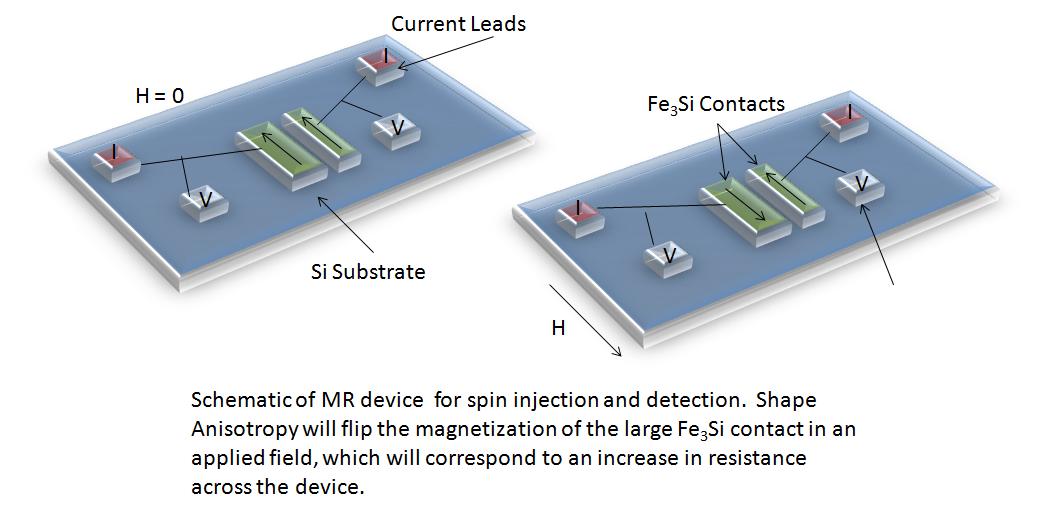 ellman Group
ellman Group
 ellman Group
ellman Group
Our research group is exploring how properties of amorphous materials may be tuned by changing their structure. While it is well understood how defects modify physical properties of crystalline materials, it is still a challenge to understand how, or even why, amorphous materials show different physical properties, such as thermodynamic stability or low temperature quantum phenomena. We vary growth conditions of several amorphous materials and characterize both the resulting structural and functional changes. We use amorphous silicon and alumina as model systems to probe how defects like tunneling two-level systems and dangling bonds affect physical properties such as optical absorption and mechanical loss (LIGO project) and dielectric loss (quantum bits).
We have developed a series of experiments based on MEMS "lab-on-a-chip" devices utilizing a silicon nitride membrane as a thermal isolation platform which allows us to study orders of magnitude smaller sample sizes than other available thermodynamic measurements such as thin films (as thin as 20nm), nanoparticles, and tiny crystals. Experiments include heat capacity measurements, thermal conductivity and thermopower measurements.
We have modified this membrane-based device into a portable heater stage that is transparent to x-rays for use in in-situ temperature-dependent measurements in facilities that do not support macroscale heating such as sensitive x-ray beamlines at synchrotrons. Our latest development of the device consists in adding a thin biaxially oriented MgO layer for epitaxial growth of thin films on the amorphous silicon nitride membrane.
We study a wide range of materials; current projects include ferromagnetic and antiferromagnetic thin films and nanoparticles, studying the effects of disorder on the magnetic, transport, and thermodynamic properties of magnetic materials and relaxor ferroelectrics, and low temperature thermal properties of amorphous materials.
We currently have openings for graduate students in a variety of projects, including studying the thermodynamics of magnetocaloric materials, multilayers systems, semiconductor nanowires, and various magnetic materials.
Below you can see some of our past and ongoing research projects.

The low temperature thermal properties of amorphous solids are known to be markedly different from their crystalline counterparts due to low energy excitations not typically found in crystalline materials. These excitations result in an increase in the low temperature heat capacity and cause strong scattering of phonons and elastic waves. Many of these properties are explained by the two-level systems (TLS) which explains a wide range of experimental results but it offers little insight into the physical nature of the tunneling entities themselves. Despite 40 years of active research several open questions remain: Why are TLS found with roughly the same density in most amorphous solids? Are these excitations intrinsic to the amorphous state? Do TLS form in tetrahedral bonded materials like a-Si and a-Ge? Interest has been renewed in understanding the origin of TLS as they cause decoherence in solid state qubits and noise in superconducting resonators.
We are addressing these questions using a-Si as model system. We have found that the TLS density in e-beam evaporated a-Si decrease by several orders of magnitude as the density of the amorphous film approaches the crystalline value. This result suggest that TLS form in low density regions of the film that are distinct from the average sited in disordered amorphous matrix.

This work is performed in collaboration with the Lawrence Berkeley National Lab, the National Renewable Energy Lab, and the Naval Research Lab.
D.R.Queen, X. Liu, J. Karel, T.H. Metcalf, and F. Hellman Phys. Rev. Lett. 110 135901 (2013). link
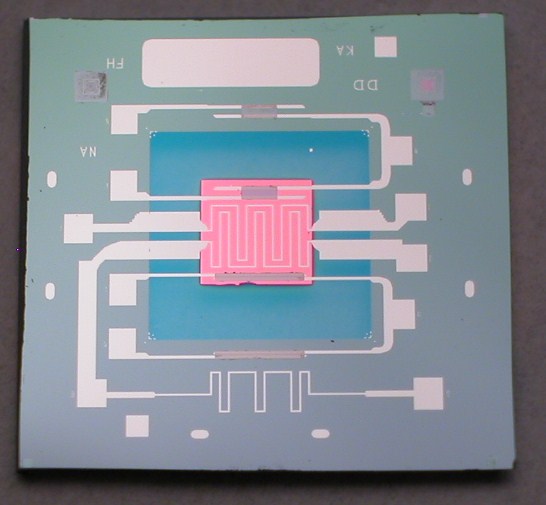
This is one of the only labs in the world with the unique capability to perform heat capacity and thermodynamic measurements on thin film samples. We fabricate membrane-based thermal isolation nanocalorimeter devices in order to take these measurements. In addition to measuring amorphous samples, we have developed the capability to grow epitaxial samples on the membranes of the devices using ion beam assisted deposition (IBAD) MgO.
Current nanocalorimetry research involves measuring the magnetocaloric effect of magnetic thin film materials. The materials being studied exhibit a giant magnetocaloric effect due to their magnetic phase transitions. Calorimetry is the only measurement technique that can fully characterize a material's magnetocaloric behavior, and few other labs are equipped to take these measurements. Harnessing the magnetocaloric effect at phase transitions can advance magnetic cooling technology applications.
Giant magneto-resistance (GMR) was first discovered in iron-chromium magnetic multi-layers (Fe-Cr MMLs) twenty-plus years ago. This unique structure coupling the spin and conduction of the electrons set in motion an avalanche of technological innovation such as the data storage revolution of the mid-nineties and the emergent field of spintronics, which is why the co-discoverers of the phenomena (Fert and Grunberg) were awarded the Nobel Prize in Physics in 2007.
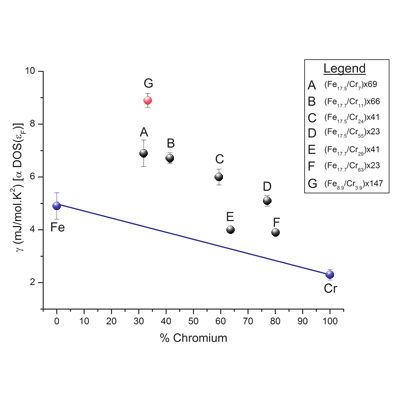
The densities of state of the materials in the MML structure play a key role in the system’s coupling behavior. Our group utilizes our novel heat capacity devices to directly probe the density of states of these materials [1]. The data shown below indicates a very large enhancement in the DOS at the Fermi energy in Fe-Cr MMLs. Ongoing research is examining the relationship of this enhancement to effects at the Fe-Cr interface to further our understanding of the spin-dependent scattering that results in GMR.
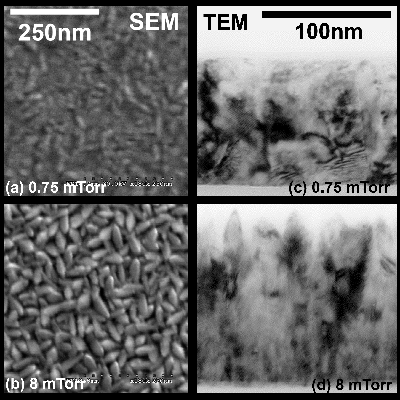
A tangential project to the work on GMR materials is that of the complex AFM Cr used as the “non-magnetic” spacer. Through our unique thin film growth capabilities, we have shown how the spin density wave in this interesting transitional metal can exhibit a number of characteristics not seen in the bulk [2].
Related publications:
[1] Enhancement of the electronic contribution to the low temperature specific heat of an Fe/Cr magnetic multilayer. B. Revaz, M.-C. Cyrille, B. Zink, I. K. Schuller and F. Hellman, Phys. Rev. B 65, 944171 (2002). link
[2] Spin-density wave in polycrystalline Cr films from infrared reflectivity. Z. Boekelheide, E. Helgren, F. Hellman, Phys. Rev. B, 76, 224429 (2007). link
There has been great interest in the utilizing of physical properties of magneto-electronics which is a new developing field, where the two degrees of freedom, the charge and the spin of the carriers, are utilized simultaneously to create new functionalities. Many promising applications of ferromagnetic semiconductors have been already demonstrated for (Ga,Mn)As, but the low Curie temperature (< 110 K) prohibited the operation at room temperature. Recently oxide semiconductors doped with transition metal magnetic impurities, called diluted magnetic oxides such as TiO2, ZnO and SnO2, have attracted much attention due to their potential for high Curie temperatures.
Given that the carries in magnetic oxides reside in an insulating impurity band, there are essentially four kinds of carrier-mediated magnetic exchange interactions which could potentially lead intrinsic carrier-mediated ferromagnetism: double exchange in the impurity [1], bound magnetic polarons percolation [2], indirect exchange coupling mediated by free carriers [3], and hydrogen mediated spin-spin exchange [4]. However, there is currently no consensus on the origin of ferromagnetism in the oxide-dilute magnetic semiconductor.
We are studying on ZnO based diluted magnetic oxide semiconductor which is grown by e-beam evaporator and sputtering system. Epitaxial film on crystal substrate is grown at high temperature and it is characterized by high-resolution x-ray diffraction. The magnetism is controlled by carrier density though electron accumulation.
[1] C. Zener, Phys. Rev. 82, 402405 (1951).
[2] A. Kaminski and S. Das Sarma, Phys. Rev. Lett. 88, 247202 (2002).
[3] D. J. Priour, Jr., E. H. Hwang, and S. Das Sarma, Phys. Rev. Lett. 92, 117201 (2004).
[4] C. H. Park and D. J. Chadi, Phys. Rev. Lett. 94, 127204 (2005).
We study the metal-insulator transition (MIT) in magnetically doped semiconductors. This MIT is a type of Quantum Phase Transition, a phase transition which is achieved by tuning some other parameter in the ground state Hamiltonian other than temperature (electronic concentration, pressure or magnetic field). Proximal to this Quantum Phase Transition a quantum critical scaling is expected for the various physical observables of the system.

We have observed that the dc conductivity, σDC(H,T,x), of Gd-doped amorphous silicon, a-GdxSi1-x, a system which undergoes both a concentration tuned, as well as a magnetic field tuned MIT, obeys scaling consistent with quantum critical behavior. In fact we have been able to show scaling for both concentration tuning (top panel) and for magnetic field tuning for a single sample (lower panel). Critical exponents agree with a disorder-driven transition in both cases.
Furthermore, for Quantum Phase Transitions, the temperature T and frequency ω should be interchangeable as seen in the non-magnetic analog system a-NbSi. We however find no T-ω scaling for a-GdSi down to 0.1 THz. We observe that the σDC(H,T) converge at T>50K whereas the real part of the complex frequency dependent optical conductivity σ1(H,ω) do not converge until nearly 1 eV. We suggest that this is due to magnetic interactions providing a separate length scale for this problem.
Molecular magnetism has been developed towards the end of the 20th century, with the growing interest in molecular materials as low cost materials whose properties can be tuned by chemical techniques. Nowadays, the continuous trend towards miniaturizing electronic devices makes the device potentials of single (non magnetic and magnetic) molecules of great interest. Also for fundamental research, magnetic molecules are very appealing because in these systems quantum properties coexist with classical ones.
Between magnetic molecules, compounds of the single molecular magnets (SMM) class are particularly attractive. The first reported and mostly investigated example of SMM is Mn12ac, which is shown in Fig.1a.
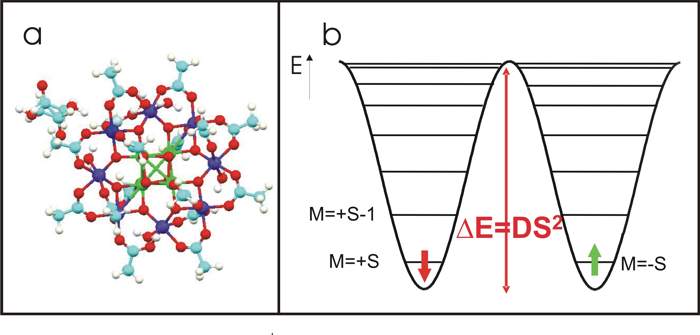
Fig.1. (a) Molecular structure of Mn12O12(CH3COO)16(H2O)4), the so called Mn12ac. The molecule is composed by an external ring of eight manganese (III) ions and an internal tetrahedron of four manganese (IV) ions. The organic environment (the ligands) is not shown. In the figure, manganese(III) ions are shown in blu, Manganese(IV) ions in green, oxygen atoms in red, carbon in cyan and hydrogen in white. (b) Anisotropy barrier (for zero magnetic field) which separates the two favorable states of the molecular spin.
SMMs are clusters of transition metal ions, characterized by large spin of the ground state (S=10-20). When the spin ground state is associated with easy axis magnetic anisotropy (Ising type), a double well potential with an energy barrier which separates the two favorite orientations of the magnetization is present (see Fig.1b). This barrier is at the origin of extremely long magnetization relaxation times at low temperature. Such an effect is a property of the isolated molecule and not a cooperative feature as in traditional magnetic materials (that is why they are called single molecular magnets!). Therefore it is in principle possible to store information in one single molecule. This property makes SMM appealing for potential use as magnetic memories with very high storage density.
We are interested in the magnetic and electronic properties of magnetic molecules and SMM adsorbed in the sub-monolayer regime on surfaces of ultra-thin magnetic and non-magnetic films. We are investigating how the electronic transport of ultra-thin films is influenced by the presence of the molecular magnetic moments adsorbed on their surfaces.
For transport measurements, we use insulating substrates with pre-fabricated leads which define the electrode geometries (see Fig.2). We evaporate the thin films using shadow masks and measure the conductivity of the films in situ with the four probe method.
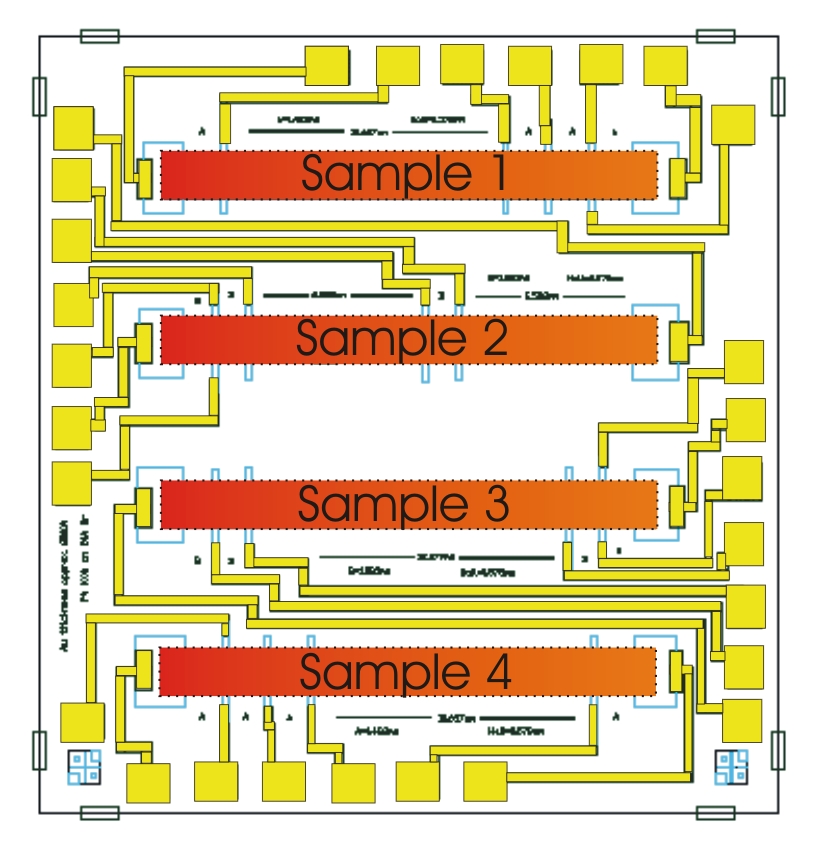
Fig.2. Schematic of sample. The insulating substrate is made of 4000 Å of amorphous SiNx grown on a Si wafer (about 520 μm thick). The leads are gold (yellow) on cromium and platinum (azure), 1000 Å and 100 Å respectively. Four different samples (orange) can be grown on such a device. We delimited their geometry during the thin film deposition using a shadow mask. Due to the fixed sample geometry we measure the resistance per square.
For magnetization and magneto-transport measurements we use a SQUID magnetometer (able to apply magnetic fields up to 7T) which is able to detect magnetic moments as low as 10-9 emu.
Our research is now focused on the development of techniques for adsorption of SMM on surfaces, growth and characterization of ultra-thin films whose transport properties change drastically due to the presence of few magnetic moments on their surfaces.
This project is part of an NSF NIRT grant called "Molecular Spin-Active Nanoelectronics". Member of this grant is an interdisciplinary team that includes members from the Physics and Chemistry of UC Berkeley and Harvard, as well as the microscopy group at the IBM Almaden Research Center.
Spin Injector and Detector Characterization and Fabrication
One portion of the project focuses on characterization of iron-silicide (Fe3Si) for use as a spin injector and detector. Current research efforts include stabilizing an epitaxial bcc iron-rich phase on Si and understanding how different compositions of this phase affect transport and magnetic properties. The ability to precisely control these properties is essential in developing a spintronic device. The second portion of this project foscuses on development of a device to inject and subsequently detect spin polarized electrons in silicon. Current research efforts are focused on taking advantage of shape anisotropy to modulate the resistance of the device.
